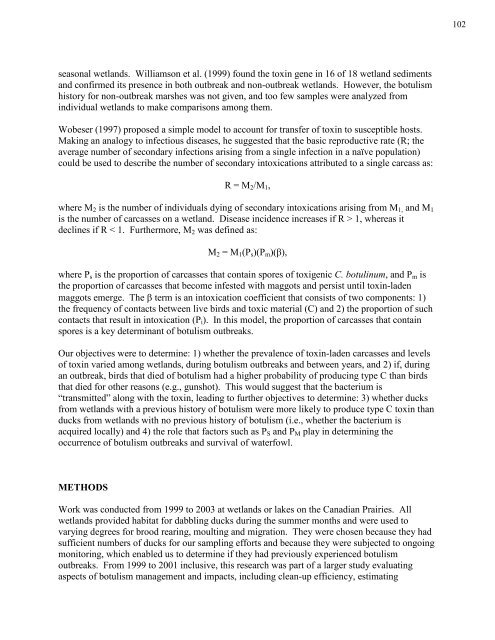Ecology and Management of Avian Botulism on the Canadian Prairies
Ecology and Management of Avian Botulism on the Canadian Prairies
Ecology and Management of Avian Botulism on the Canadian Prairies
Create successful ePaper yourself
Turn your PDF publications into a flip-book with our unique Google optimized e-Paper software.
102seas<strong>on</strong>al wetl<str<strong>on</strong>g>and</str<strong>on</strong>g>s. Williams<strong>on</strong> et al. (1999) found <strong>the</strong> toxin gene in 16 <str<strong>on</strong>g>of</str<strong>on</strong>g> 18 wetl<str<strong>on</strong>g>and</str<strong>on</strong>g> sediments<str<strong>on</strong>g>and</str<strong>on</strong>g> c<strong>on</strong>firmed its presence in both outbreak <str<strong>on</strong>g>and</str<strong>on</strong>g> n<strong>on</strong>-outbreak wetl<str<strong>on</strong>g>and</str<strong>on</strong>g>s. However, <strong>the</strong> botulismhistory for n<strong>on</strong>-outbreak marshes was not given, <str<strong>on</strong>g>and</str<strong>on</strong>g> too few samples were analyzed fromindividual wetl<str<strong>on</strong>g>and</str<strong>on</strong>g>s to make comparis<strong>on</strong>s am<strong>on</strong>g <strong>the</strong>m.Wobeser (1997) proposed a simple model to account for transfer <str<strong>on</strong>g>of</str<strong>on</strong>g> toxin to susceptible hosts.Making an analogy to infectious diseases, he suggested that <strong>the</strong> basic reproductive rate (R; <strong>the</strong>average number <str<strong>on</strong>g>of</str<strong>on</strong>g> sec<strong>on</strong>dary infecti<strong>on</strong>s arising from a single infecti<strong>on</strong> in a naïve populati<strong>on</strong>)could be used to describe <strong>the</strong> number <str<strong>on</strong>g>of</str<strong>on</strong>g> sec<strong>on</strong>dary intoxicati<strong>on</strong>s attributed to a single carcass as:R = M 2 /M 1 ,where M 2 is <strong>the</strong> number <str<strong>on</strong>g>of</str<strong>on</strong>g> individuals dying <str<strong>on</strong>g>of</str<strong>on</strong>g> sec<strong>on</strong>dary intoxicati<strong>on</strong>s arising from M 1, <str<strong>on</strong>g>and</str<strong>on</strong>g> M 1is <strong>the</strong> number <str<strong>on</strong>g>of</str<strong>on</strong>g> carcasses <strong>on</strong> a wetl<str<strong>on</strong>g>and</str<strong>on</strong>g>. Disease incidence increases if R > 1, whereas itdeclines if R < 1. Fur<strong>the</strong>rmore, M 2 was defined as:M 2 = M 1 (P s )(P m )(β),where P s is <strong>the</strong> proporti<strong>on</strong> <str<strong>on</strong>g>of</str<strong>on</strong>g> carcasses that c<strong>on</strong>tain spores <str<strong>on</strong>g>of</str<strong>on</strong>g> toxigenic C. botulinum, <str<strong>on</strong>g>and</str<strong>on</strong>g> P m is<strong>the</strong> proporti<strong>on</strong> <str<strong>on</strong>g>of</str<strong>on</strong>g> carcasses that become infested with maggots <str<strong>on</strong>g>and</str<strong>on</strong>g> persist until toxin-ladenmaggots emerge. The β term is an intoxicati<strong>on</strong> coefficient that c<strong>on</strong>sists <str<strong>on</strong>g>of</str<strong>on</strong>g> two comp<strong>on</strong>ents: 1)<strong>the</strong> frequency <str<strong>on</strong>g>of</str<strong>on</strong>g> c<strong>on</strong>tacts between live birds <str<strong>on</strong>g>and</str<strong>on</strong>g> toxic material (C) <str<strong>on</strong>g>and</str<strong>on</strong>g> 2) <strong>the</strong> proporti<strong>on</strong> <str<strong>on</strong>g>of</str<strong>on</strong>g> suchc<strong>on</strong>tacts that result in intoxicati<strong>on</strong> (P i ). In this model, <strong>the</strong> proporti<strong>on</strong> <str<strong>on</strong>g>of</str<strong>on</strong>g> carcasses that c<strong>on</strong>tainspores is a key determinant <str<strong>on</strong>g>of</str<strong>on</strong>g> botulism outbreaks.Our objectives were to determine: 1) whe<strong>the</strong>r <strong>the</strong> prevalence <str<strong>on</strong>g>of</str<strong>on</strong>g> toxin-laden carcasses <str<strong>on</strong>g>and</str<strong>on</strong>g> levels<str<strong>on</strong>g>of</str<strong>on</strong>g> toxin varied am<strong>on</strong>g wetl<str<strong>on</strong>g>and</str<strong>on</strong>g>s, during botulism outbreaks <str<strong>on</strong>g>and</str<strong>on</strong>g> between years, <str<strong>on</strong>g>and</str<strong>on</strong>g> 2) if, duringan outbreak, birds that died <str<strong>on</strong>g>of</str<strong>on</strong>g> botulism had a higher probability <str<strong>on</strong>g>of</str<strong>on</strong>g> producing type C than birdsthat died for o<strong>the</strong>r reas<strong>on</strong>s (e.g., gunshot). This would suggest that <strong>the</strong> bacterium is“transmitted” al<strong>on</strong>g with <strong>the</strong> toxin, leading to fur<strong>the</strong>r objectives to determine: 3) whe<strong>the</strong>r ducksfrom wetl<str<strong>on</strong>g>and</str<strong>on</strong>g>s with a previous history <str<strong>on</strong>g>of</str<strong>on</strong>g> botulism were more likely to produce type C toxin th<str<strong>on</strong>g>and</str<strong>on</strong>g>ucks from wetl<str<strong>on</strong>g>and</str<strong>on</strong>g>s with no previous history <str<strong>on</strong>g>of</str<strong>on</strong>g> botulism (i.e., whe<strong>the</strong>r <strong>the</strong> bacterium isacquired locally) <str<strong>on</strong>g>and</str<strong>on</strong>g> 4) <strong>the</strong> role that factors such as P S <str<strong>on</strong>g>and</str<strong>on</strong>g> P M play in determining <strong>the</strong>occurrence <str<strong>on</strong>g>of</str<strong>on</strong>g> botulism outbreaks <str<strong>on</strong>g>and</str<strong>on</strong>g> survival <str<strong>on</strong>g>of</str<strong>on</strong>g> waterfowl.METHODSWork was c<strong>on</strong>ducted from 1999 to 2003 at wetl<str<strong>on</strong>g>and</str<strong>on</strong>g>s or lakes <strong>on</strong> <strong>the</strong> <strong>Canadian</strong> <strong>Prairies</strong>. Allwetl<str<strong>on</strong>g>and</str<strong>on</strong>g>s provided habitat for dabbling ducks during <strong>the</strong> summer m<strong>on</strong>ths <str<strong>on</strong>g>and</str<strong>on</strong>g> were used tovarying degrees for brood rearing, moulting <str<strong>on</strong>g>and</str<strong>on</strong>g> migrati<strong>on</strong>. They were chosen because <strong>the</strong>y hadsufficient numbers <str<strong>on</strong>g>of</str<strong>on</strong>g> ducks for our sampling efforts <str<strong>on</strong>g>and</str<strong>on</strong>g> because <strong>the</strong>y were subjected to <strong>on</strong>goingm<strong>on</strong>itoring, which enabled us to determine if <strong>the</strong>y had previously experienced botulismoutbreaks. From 1999 to 2001 inclusive, this research was part <str<strong>on</strong>g>of</str<strong>on</strong>g> a larger study evaluatingaspects <str<strong>on</strong>g>of</str<strong>on</strong>g> botulism management <str<strong>on</strong>g>and</str<strong>on</strong>g> impacts, including clean-up efficiency, estimating


